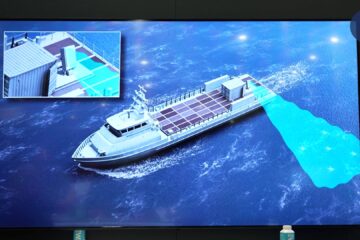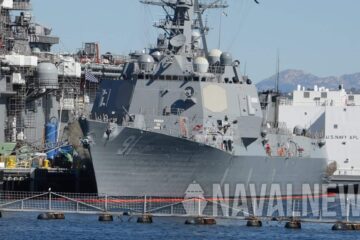The US Navy has set itself a ‘North Star’ aimpoint of 75 mission-capable ships. These ships should be “ready on any given day”, Vice Admiral Roy Kitchener – Commander Naval Surface Forces, and Commander Naval Surface Force US Pacific Fleet – told the symposium on 10 January.
This aim “is the single point of focus that drives all of our efforts in the surface community”, Vice Adm Kitchener continued. “We need to act with an urgency in preparing our sailors and our ships, to get them ready.”
“This imperative for 75 drives every programme and action we take,” he said. “Across our force, our entire surface enterprise is aligned to reach this ‘North Star’.”
“This goal … was born from our investments in data analytics, a very thorough assessment of operational requirements,” the admiral explained. “Maintaining the mission-capable ships we have, and accelerating readiness in those that are not [mission-capable], is the whole purpose of a data-driven approach. It is how we get more ships ready.”
“Now more than ever before, we are making better informed, data informed, decisions and focusing targeted investments in equipment, spares, manning actions, and scheduling, identifying the key levers to produce more mission-capable ships and to sustain them longer.”
Vice Admiral Roy Kitchener, Commander Naval Surface Forces, and Commander Naval Surface Force US Pacific Fleet
Vice Adm Kitchener pointed to three areas where the surface force is re-organising itself to meet this new demand.
First, it is creating a Surface Response Plan for the US Navy to prioritise and allocate ships that are ready to deploy.
Second, under the different ship type commanders, US Navy Surface Maintenance Operations Centers (SMOCs) are being established to build readiness by driving down equipment casualty reports and prioritising repairs and spare parts.
Third, in geographical areas ashore where the fleet is concentrated, Surface Readiness Groups are being established to manage ships through their maintenance and basic phases, and to maintain oversight of readiness during all follow-on phases.
“These commands will be better positioned to support our ships and our numbered Fleet Commanders as we make our surface force more ready,” said Vice Adm Kitchener.
Much has been learned already in this process of improving readiness, the admiral explained.
“One of the greatest benefits of data analytics is the ability to pinpoint key factors impacting our readiness.” For example, in terms of what he referred to as “underfunded sparing”, Vice Adm Kitchener said “We can now clearly identify specific negative impacts to logistics, self-sufficiency, and combat readiness – but also identify the solutions needed.”
Overall, Vice Adm Kitchener concluded, “We know which systems, which ships, and what classes of ships should be prioritised, and need continued, detailed, and persistent advocacy with the OPNAV Staff and our Systems Commands to secure the funding to address [any] shortfalls in both the near and the long term.”
“That’s how we get to 75, and that’s how we get more ready,” the admiral said.






